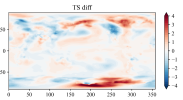Hello, I made an intresting test that the pelayout of POP will significantly affect the result. I run two similar run of compset B1PCTcmip6 for 1 year. The only difference between them is the pelayout.
case1 is:
Why the TS difference is so high?

case1 is:
case 2 is:Comp NTASKS NTHRDS ROOTPE
CPL : 768/ 1; 0
ATM : 768/ 1; 0
LND : 320/ 1; 0
ICE : 448/ 1; 320
OCN : 640/ 1; 768
ROF : 320/ 1; 0
GLC : 32/ 1; 0
WAV : 32/ 1; 1408
ESP : 1/ 1; 0
The CAM output "TS" difference between them is (case 2 minus case 1) shown in the picture:Comp NTASKS NTHRDS ROOTPE
CPL : 768/ 1; 0
ATM : 768/ 1; 0
LND : 320/ 1; 0
ICE : 448/ 1; 320
OCN : 1280/ 1; 768
ROF : 320/ 1; 0
GLC : 32/ 1; 0
WAV : 32/ 1; 2048
ESP : 1/ 1; 0
Why the TS difference is so high?

